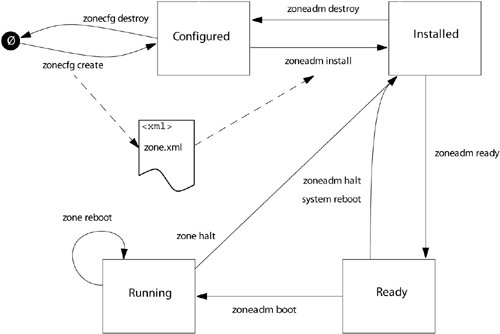Section 6.2. Zone Runtime
6.2. Zone RuntimeThis section explains the overall structure of the zone runtime, including the zoneadmd(1M) daemon. Most of this information is knowledge that global administrators will need to understand before deploying zones; zone administrators are not required to understand these topics. 6.2.1. Zone State ModelThe administrative tasks mentioned in the chapter introduction are managed as transitions in a finite state machine. This section describes the states that form the state machine abstraction. See Figure 6.2 for a graphical representation of this model. A zone can be in one of six states:
Figure 6.2. Zones State Diagram The following section shows how to use the zoneadm(1M) command to initiate transitions between these states. 6.2.2. Zone Names and Numeric IDsEach zone, including the global zone, is assigned a zone name. The rules for a valid zone name are similar to those for host names: They must start with an alphanumeric character, and all remaining characters must consist of alphanumerics plus "-" and "_". The name "global" is reserved for the global zone; also reserved is any name beginning with "SUNW". Each zone is dynamically assigned a unique numeric zone identifier (or zoneid) when the zone is made ready; this ID uniquely identifies the zone on a given system while the zone is in the ready or running state. The global zone always has the name "global", is always mapped to ID 0, and is always reported as running. Zone names and IDs are generally of little interest within non-global zones. The zonename(1) command can be useful for distinguishing between zones. It is worth noting that each zone also has a node name (that is, returned by uname -n in the zone). Unlike the zone name, the node name for each zone is under the control of the zone administrator and generally of little interest to other zones. The node name is completely independent of the zone name. 6.2.3. Zone Runtime SupportTo manage the virtual platform and the application environment, two new processes are used by the zone runtime. zoneadmd manages most of the resources associated with the zone. zsched is a system process (like sched) that tracks kernel resources associated with the zone. 6.2.3.1. zoneadmd(1M)zoneadmd(1M) is the primary process responsible for managing the zone's virtual platform. It is also responsible for setup and teardown of the application environment. There is one zoneadmd running for each active (ready, running, shutting_down) zone on the system. The zoneadmd command is responsible for consulting the zone configuration and then setting up the zone as directed. This entails the following:
zoneadmd is automatically started by zoneadm(1M) if not already running and can be contacted by userland applications (such as zoneadm in the global zone) and the kernel (as part of uadmin(2) calls from the managed zone). An example of zoneadmd in action is as follows: # dtrace -qn 'proc:::exec-success { printf("%-14s %s\n", curthread->t_procp->p_parent->p_user.u_comm, curpsinfo->pr_psargs); }' bash zoneadm -z demozone boot zoneadm zoneadmd -z demozone zoneadmd mount -o zonedevfs /zones/demozone/dev /zones/demozone/root/dev zoneadmd mount -o ro,nosub,nodevices /lib /zones/demozone/root/lib zoneadmd mount -o ro,nosub,nodevices /platform /zones/demozone/root/platform zoneadmd mount -o ro,nosub,nodevices /sbin /zones/demozone/root/sbin zoneadmd mount -o ro,nosub,nodevices /usr /zones/demozone/root/usr zoneadmd devfsadm -z demozone zsched /sbin/init init INITSH -c exec /lib/svc/bin/svc.startd >/dev/msglog 2<>/dev/msglog </ dev/consol init /lib/svc/bin/svc.startd svc.startd /lib/svc/bin/svc.configd svc.startd /sbin/sh -c exec /lib/svc/method/fs-root svc.startd /sbin/sh /lib/svc/method/fs-root fs-root /sbin/zonename fs-root /usr/bin/moe -32 /usr/lib/libc/$HWCAP fs-root egrep -s ^/lib/libc.so.1 on egrep /usr/sbin/mount fs-root /usr/sbin/mount -O -F lofs /usr/lib/libc/libc_hwcap1.so.1 /lib/libc.so.1 fs-root mount -O /usr/lib/libc/libc_hwcap1.so.1 /lib/libc.so.1 svc.startd /sbin/sh -c exec /lib/svc/method/net-physical svc.startd /sbin/sh /lib/svc/method/net-physical net-physical /sbin/zonename ... 6.2.3.2. zschedEvery active (ready through shutting_down) zone has an associated kernel process, zsched. Kernel threads doing work on behalf of the zone are owned by zsched. It exists largely to enable the zones subsystem to keep track of per-zone kernel threads. 6.2.4. Listing Zone InformationPulling together the concepts presented in this chapter thus far, we can employ the zoneadm(1M) command to observe zones on the system. zoneadm is the primary tool used to manage zones once they have been configured. This command can be used to list zones. global# zoneadm list -cv ID NAME STATE PATH 0 global running / - my-zone configured /aux0/my-zone - fun installed /aux0/fun 15 nofun ready /aux1/nofun 7 lucky running /aux0/lucky 13 unlucky shutting_down /aux1/unlucky global# pgrep -lf zoneadmd 100819 zoneadmd nofun 100227 zoneadmd lucky 100304 zoneadmd unlucky The -c flag lists all zones (even those not yet installed) instead of the default of all running zones; the -v flag specifies a verbose listing. It is useful to note that, as expected, zones that are configured or installed have no associated numeric ID. |
EAN: 2147483647
Pages: 244